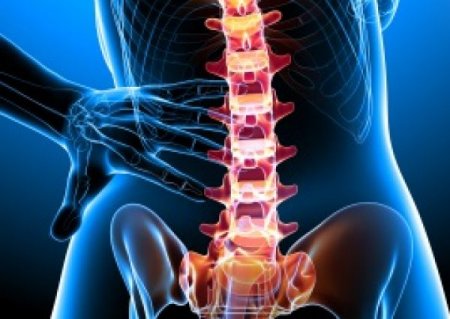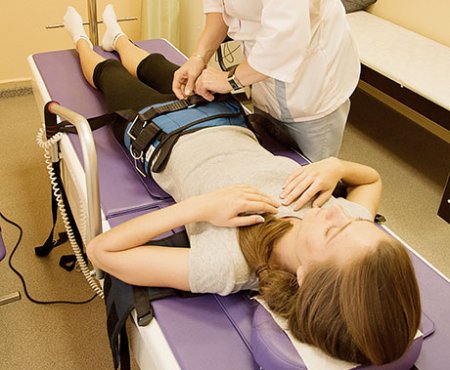What hurts the spine hernias
The mechanisms of pain in spinal hernias
When the output of the spinal disc nucleus in one direction or another happens compression of the nerve bundles emanating from the spinal cord in the trunk of each vertebra. The central nervous system of the spinal cord has a segmental structure. There are the following departments of the innervation of specific areas:
Neck;
Breast;
Lumbar;
Sacral.
Nerve fibers emanating from the vertebral column on both sides of the body provide locomotor activity and sensitivity of the left or right. Accordingly, there are pains in spinal hernia in those departments where localized anatomical destruction of intervertebral discs.
What a pain in spinal hernia in the localization in different parts of the spinal cord
Pain at hernias of intervertebral discs are not only in intensity, but also on location.
Hernias of the cervical provoke pain in the upper limbs and shoulder girdle, and are characterized by strong, paroxysmal headaches. With the progression of the disease pain in hernia cervical spine provoke muscle spasm. As a result, the patient can not turn his head. Most cervical spine herniation accompanied by dizziness, caused by differences in blood pressure. Patients exhibiting diagnosed with vascular dystonia, which is treated symptomatically. However, the cause is not eliminated. Meanwhile, the herniated disc progresses. Headache in a pathology has some peculiarities. It manifests itself not on the affected side of the spine, and has a diffuse character. Starting with occipital headaches with spinal hernia distributed throughout the skull. A man can not take a comfortable sleeping position. With high pillow headache, low - intensity of the pain is not reduced. Develops insomnia. Hypnotics have no effect, because the inhibition of the central nervous system does not eliminate the causes mechanical compression of the nerve roots.
The defeat of the intervertebral thoracic disc appears intercostal neuralgia, which initially mimics cardiac pathology. There are chest pain due to plexus lesion. Further development of the disease leads to disruption of cardiac innervation and myocardial automaticity to fail. Arrhythmias without anatomical areas of myocardial damage is often accompanied by herniation of the thoracic spine.
Lumbar physiologically combined with sacral. In the area of ??the lumbosacral junction is localized anatomical education, referred to as the "ponytail spinal cord." With his defeat of pain in spinal hernias are accompanied by disorders of pelvic organs. Disturbed urination as a delay or urinary incontinence, constipation alternating with diarrhea.
The initial stage of the disease is characterized by severe pain on the type lumbago - lumbago. At the time of an acute attack man dies, can neither bend nor straighten up. Here is what the pain of herniated spine guard in the first place, because in the current long-term osteochondrosis patient gradually adapts to pain, accustomed to the fact that his movements are limited by pain. If the herniated disc is formed, all previous efforts to overcome it cease to be effective.
Why and how sore leg with spinal hernia
Innervation of the lower extremity depends on specific segments of the spine, or rather originating from nerve bundles in the fourth and fifth lumbar vertebrae. With the defeat of the intervertebral disc between the L4 and L5 (Latin letter «L» - «lyumbalis" means "lumbar") develops radicular syndrome with a lesion of the femoral nerve. At the same hurts foot in spinal hernia on the outside, from the hip to the little finger. When a hernia is formed at the L5-S1 level ( "lyumbalis-sakralis": in the lumbosacral region), pain in the lower limb extends along the sciatic nerve. Pain starts from buttocks area and continues to the back of the thigh to the big toe. With further progression of the disease develop a violation of sensitivity and muscle atrophy.
How to eliminate pain in spinal hernia
Acute pain is accompanied by paralysis of the legs or arms, can not be removed by any medication. Disorders of the pelvic organs as a "cauda equina syndrome" should only be operative treatment. Analgesia in which case the supply of general anesthesia and subsequent removal of the intervertebral disc and its sequestration guarantees the absence of pain after surgery.
But to remove the pain of the spine and hernia can be conservatively. To date, there are two methods of pain relief during intervertebral hernia. Supporters of the classical approach in the treatment of bed rest is recommended in the acute period. nonsteroidal anti-inflammatory drug used to relieve swelling of nerve tissue. In a state of improvement prescribe massage, physiotherapy, medical gymnastics. In acute, shooting pain produced blockade of pain medication and vitamins.
Supporters of the active offer of tactics to remove the pain of spinal hernias through exercise, extend the spine. Hood relieves the load on the spine and the pressure inside the nucleus pulposus. As a result, reduced pain or disappear altogether.
Active method requires medical supervision as independent attempts to extract the spine can lead to loss of the disk and the formation of sequestration.
When the output of the spinal disc nucleus in one direction or another happens compression of the nerve bundles emanating from the spinal cord in the trunk of each vertebra. The central nervous system of the spinal cord has a segmental structure. There are the following departments of the innervation of specific areas:
Neck;
Breast;
Lumbar;
Sacral.
Nerve fibers emanating from the vertebral column on both sides of the body provide locomotor activity and sensitivity of the left or right. Accordingly, there are pains in spinal hernia in those departments where localized anatomical destruction of intervertebral discs.
What a pain in spinal hernia in the localization in different parts of the spinal cord
Pain at hernias of intervertebral discs are not only in intensity, but also on location.
Hernias of the cervical provoke pain in the upper limbs and shoulder girdle, and are characterized by strong, paroxysmal headaches. With the progression of the disease pain in hernia cervical spine provoke muscle spasm. As a result, the patient can not turn his head. Most cervical spine herniation accompanied by dizziness, caused by differences in blood pressure. Patients exhibiting diagnosed with vascular dystonia, which is treated symptomatically. However, the cause is not eliminated. Meanwhile, the herniated disc progresses. Headache in a pathology has some peculiarities. It manifests itself not on the affected side of the spine, and has a diffuse character. Starting with occipital headaches with spinal hernia distributed throughout the skull. A man can not take a comfortable sleeping position. With high pillow headache, low - intensity of the pain is not reduced. Develops insomnia. Hypnotics have no effect, because the inhibition of the central nervous system does not eliminate the causes mechanical compression of the nerve roots.
The defeat of the intervertebral thoracic disc appears intercostal neuralgia, which initially mimics cardiac pathology. There are chest pain due to plexus lesion. Further development of the disease leads to disruption of cardiac innervation and myocardial automaticity to fail. Arrhythmias without anatomical areas of myocardial damage is often accompanied by herniation of the thoracic spine.
Lumbar physiologically combined with sacral. In the area of ??the lumbosacral junction is localized anatomical education, referred to as the "ponytail spinal cord." With his defeat of pain in spinal hernias are accompanied by disorders of pelvic organs. Disturbed urination as a delay or urinary incontinence, constipation alternating with diarrhea.
The initial stage of the disease is characterized by severe pain on the type lumbago - lumbago. At the time of an acute attack man dies, can neither bend nor straighten up. Here is what the pain of herniated spine guard in the first place, because in the current long-term osteochondrosis patient gradually adapts to pain, accustomed to the fact that his movements are limited by pain. If the herniated disc is formed, all previous efforts to overcome it cease to be effective.
Why and how sore leg with spinal hernia
Innervation of the lower extremity depends on specific segments of the spine, or rather originating from nerve bundles in the fourth and fifth lumbar vertebrae. With the defeat of the intervertebral disc between the L4 and L5 (Latin letter «L» - «lyumbalis" means "lumbar") develops radicular syndrome with a lesion of the femoral nerve. At the same hurts foot in spinal hernia on the outside, from the hip to the little finger. When a hernia is formed at the L5-S1 level ( "lyumbalis-sakralis": in the lumbosacral region), pain in the lower limb extends along the sciatic nerve. Pain starts from buttocks area and continues to the back of the thigh to the big toe. With further progression of the disease develop a violation of sensitivity and muscle atrophy.
How to eliminate pain in spinal hernia
Acute pain is accompanied by paralysis of the legs or arms, can not be removed by any medication. Disorders of the pelvic organs as a "cauda equina syndrome" should only be operative treatment. Analgesia in which case the supply of general anesthesia and subsequent removal of the intervertebral disc and its sequestration guarantees the absence of pain after surgery.
But to remove the pain of the spine and hernia can be conservatively. To date, there are two methods of pain relief during intervertebral hernia. Supporters of the classical approach in the treatment of bed rest is recommended in the acute period. nonsteroidal anti-inflammatory drug used to relieve swelling of nerve tissue. In a state of improvement prescribe massage, physiotherapy, medical gymnastics. In acute, shooting pain produced blockade of pain medication and vitamins.
Supporters of the active offer of tactics to remove the pain of spinal hernias through exercise, extend the spine. Hood relieves the load on the spine and the pressure inside the nucleus pulposus. As a result, reduced pain or disappear altogether.
Active method requires medical supervision as independent attempts to extract the spine can lead to loss of the disk and the formation of sequestration.

